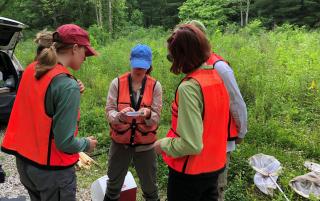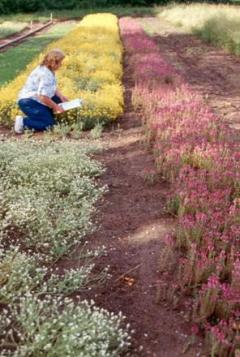USDA Forest Service land managers, scientists and partners are working together to improve pollinator habitat after timber harvest activities

The U.S. Department of Agriculture estimates that one in every three bites of food that we eat depends on pollinators.
“We all know the importance of pollinators,” said DeAnna Williams, USDA Forest Service wildlife biologist on the Siuslaw National Forest in Oregon. “Pollinators, Western bumble bee (Bombus occidentalis) and more are on the decline, and it is important that we work proactively to maintain, increase, and/or enhance habitat to try to keep pollinators off of lists of threatened species.”
Williams is one of the many USDA Forest Service land managers and scientists who are collaborating to learn more about how to increase natural habitat for pollinators after timber harvest activities. They are looking at associations between pollinators and plants, and they are working to restore soil conditions that improve the growth of the plants that pollinators need. In particular, these specialists are exploring disturbed soil restoration treatments, and which planting methods improve productivity of native plant recovery.
Can log landings (areas where harvested trees are loaded onto trucks as part of forest health management) provide healthy natural habitat for pollinators? Scientists want to learn more.
Early seral habits, ecological communities that grow after a stand-replacement disturbance), might even be more enriching for pollinators when interspersed with older forests.
Two projects are underway to try to answer that question. The PHiLL project, Pollinator Habitat in Log Landings, involves many partners and researchers in the Eastern United States, including scientists with the Northern Research Station and Rocky Mountain Research Station.
The PALs program, Pollinator Partners Across Landscapes, is focused on habitats occurring throughout the Oregon coast range that runs alongside the Pacific Ocean. There, a team including scientists with the Rocky Mountain Research Station; Western Center for Native Plant Conservation and Restoration Science; and National Council for Air and Stream Improvement is examining variables of log landings as pollinator habitat “from forest floor to ocean shore.”
These two efforts share strategies for improving soil conditions after harvest activities that encourage native plants that support pollinators.
“Log landings can be really great for pollinators,” said University of Massachusetts-Amherst graduate student Aliza Fassler.
Fassler is involved with the PHiLL project across three national forests—the Hoosier National Forest in Indiana, Mark Twain National Forest in Missouri and Shawnee National Forest in Illinois.
In her recent presentation about the PHiLL project, Fassler talked about a new study that was featured in the October 2021 issue of the Forest Ecology and Management Journal. The study concluded that microhabitats created by log landings are valuable in supporting abundant flowers and insect pollinators within regenerating mixed-oak stands in the central Appalachian Mountains.
Log landings, researchers have found, can provide 14 times as much floral resources as adjacent areas. What’s more, there are typically approximately twice as many bees present at log landings and timber harvests with diverse vegetation structure that provide pollinator habitat.
“We are hoping that we can identify best practices for closing out log landings that will be helpful in increasing natural habitat for pollinators,” Fassler said.
For PHiLL and PALs, an essential aspect of the close-out process after logging activities is restoring the soils. Researchers want to determine the best treatments to reduce the density of soil and improve the movement of oxygen, water and roots so that plants preferred by pollinators can grow better.

An important first step is mechanically reducing soil compaction from timber harvest activities, a process known as ripping. But scientists are also interested in improving soil quality and productivity by adding organic components. In particular, biochar has potential to be a game-changer on forest lands.
Biochar is helpful in a variety of ways, including reducing bulk density and improving aeration and water movement. Biochar can also improve growing conditions for plants, especially water-holding capacity.
What’s more, utilizing biochar can help reduce wildfire risk as well as the smoke emissions that come from traditional slash-pile burning. Portable biochar kilns use air-curtain technology to reduce emissions, and they allow slash piles and other forest residues to be converted to biochar that can be mechanically delivered to sites. Biochar is also a more recalcitrant form of carbon that provides long-term sequestration potential.
“Biochar can be a real win-win-win when it comes to improving soil health, increasing pollinator habitat and mitigating climate change,” Williams said.
Fassler is looking closely at how soil treatments are affecting habitat for ground-nesting bees, solitary bees that are not part of a hive. They make nests and take care of their offspring on their own. Seventy percent of the 20,000 species of bees around the world are ground-nesting.
Last summer, the PHiLL team collected vegetation and pollinator samples. To help estimate abundance and diversity of ground-nesting bees and identify their patterns, they used three methods to gather bees on the landings. One way was setting out bee bowls, tiny bowls filled with water and a little bit of soap. Bees are attracted to the bright colors and are easier to catch. They also used netting and soil emergence traps. The traps were placed randomly throughout a log landing at night, when the bees are in their nests, and they are picked up the next morning.
On the Hoosier National Forest, the team found bees on an array of many different pollinator plants, including several of the species that they seeded on the landings. They found that the plants the bees preferred most included black-eyed Susan (Rudbeckia hirta), plains coreopsis (Coreopsis tinctoria), slender mountain mint (Pyscnanthemum tenuifolium) and partridge pea (Chamaecrista fasciculata).
On the Siuslaw National Forest, efforts are underway to determine robust native plant mixtures that can make log landings even better natural habitat for pollinators (including insects, bats, hummingbirds and more) and how to enhance the abundance and diversity of floral resources in restoration areas—based on the timing, distribution, color, and shape of the flowers. They want to help ensure that deep-forest plant species, especially the fruit producers, develop robustly.
The first step is identifying pollinators on or around particular plants throughout the growing season. Some of the target plant species have long blooming durations, and scientists carefully discern the pattern to ensure that seeds are collected throughout the plant’s entire reproductive time. Seeds will be collected, processed, tested, stored and germinated in order to learn the best ways to use these plants in restoration activities.
For PHiLL and PALs, ongoing monitoring of how the soil, plants and pollinators respond to management treatments is key.
“Of course, monitoring will help describe successes and failures and create a feed-back loop to continually improve the process,” Williams said.
The diverse experience and expertise of the people involved is essential.
“Partners are the engine,” said R. Kasten Dumroese, senior scientist and research plant physiologist with the Rocky Mountain Research Station. “We intend to work with partners that represent a diversity of management needs and objectives but also recognize and embrace the importance of early forest restoration, to create that pollinator network across the coast range.”
Federal partner agencies are working together to better determine distribution and abundance through increased potential for detection of western bumblebee and other pollinators. Forest Service specialists are working closely with specialists with the U.S. Geological Survey, U.S. Fish and Wildlife Service, USDA-Agricultural Research Service, and university and industry partners in sampling of environmental DNA, or eDNA.
With each trip that a foraging arthropod makes to a flower, it leaves traces of its DNA behind. eDNA sampling is helping to improve accuracy of pollinator community assessments. Arthropod DNA is either removed and applied in a solution or, in some instances, flowers are collected and field-preserved for later processing in the lab.
“Genetic assessments improve understanding of the presence and distribution of pollinators throughout their range and could have broad implications for the way that pollinators surveys are conducted,” Dumroese said.
These efforts, focused on both the pollinators and the plants, will allow land managers and scientists in the future to monitor pollinators more efficiently and effectively.
“This will help us more fully understand and appreciate what flowers are being used by which pollinators, and our knowledge will not solely be informed by observational and trapping estimates,” Williams said.
The Forest Service and USGS are partnering in a study to test and optimize pollinator eDNA collection methods from flowers. DNA was sampled from roughly 30 locations on 14 national forests in the Pacific Northwest Region in order to test and optimize pollinator eDNA collection methods from flowers, and to assess the efficacy of detecting the western bumblebee, which is seeing a serious decline in its population.
As more and more researchers focus on ways to increase and enhance natural habitat, there is hope for the future for pollinators of all kinds.
Learn more: Pollinator Week is an annual celebration in support of pollinator health that was initiated and is managed by Pollinator Partnership. Virtual and in-person activities are featured here: Pollinator Week Activities.
During National Pollinator Week, June 20-26, 2022 – any time of year – take action to increase habitat for pollinators. Help out in a nearby community pollinator garden, or start a new pollinator garden at a library or municipal center.

